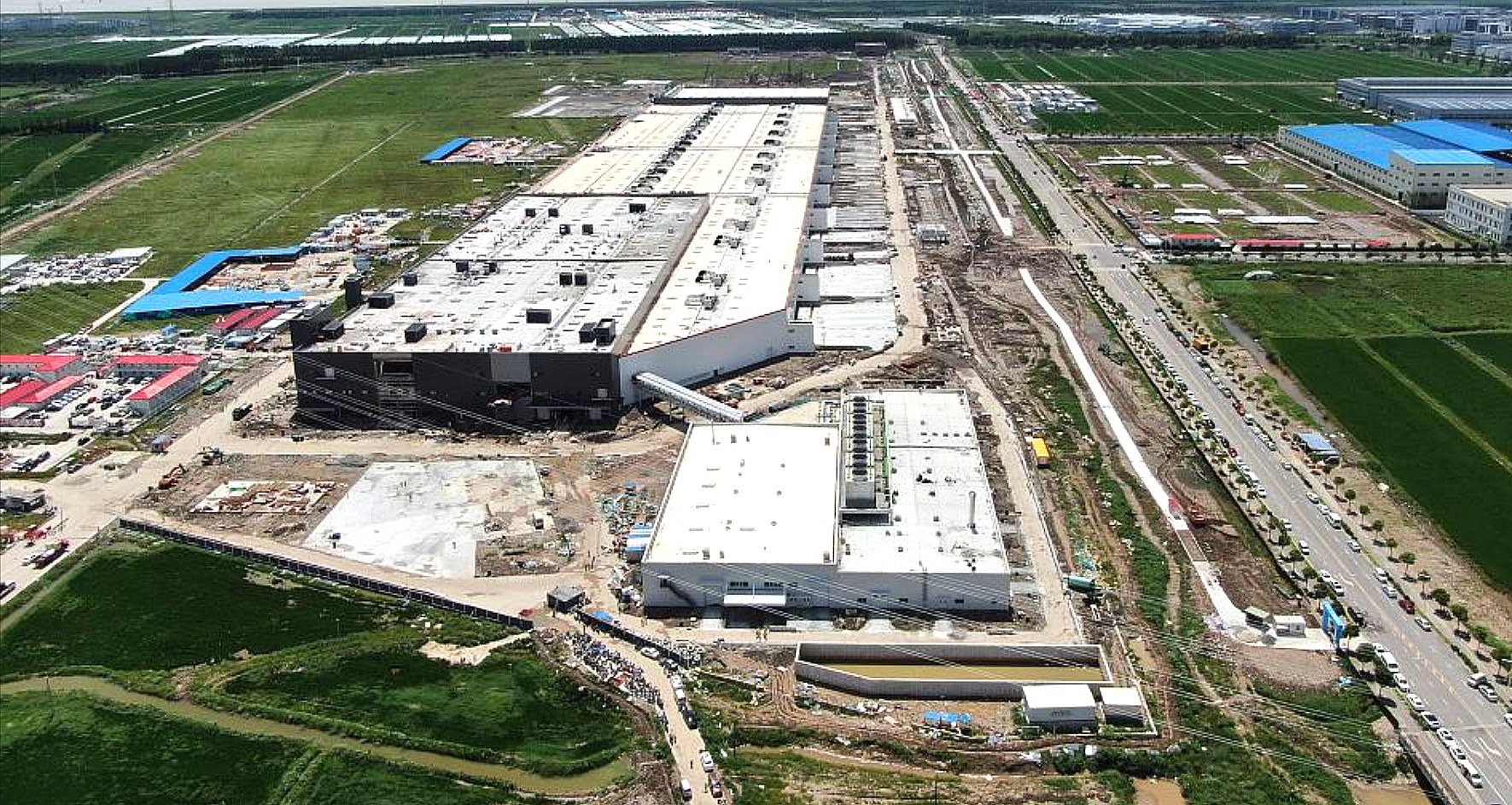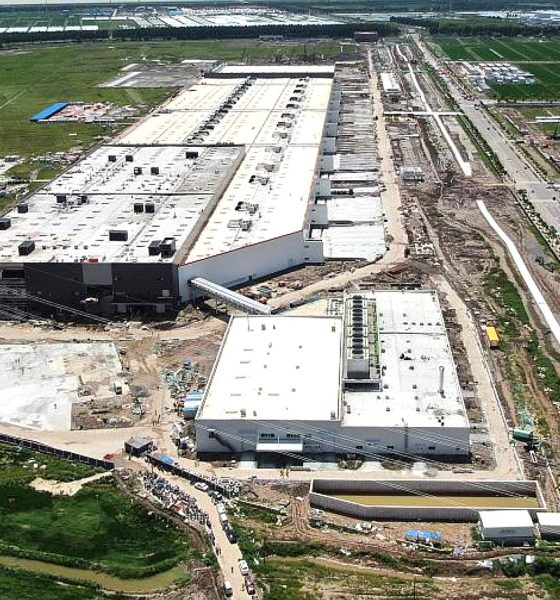

Investor's Corner
Tesla Gigafactory 3 passes major inspection amid V10’s introduction in China
Recent reports from local Chinese media have revealed that Tesla’s Gigafactory 3 complex has achieved yet another milestone. After a series of inspections on Gigafactory 3’s Phase 1 construction zone, officials have granted a ” comprehensive acceptance” of the site, paving the way for the start of Model 3 production operations in the near future.
Officials from the Lingang District Construction Project Management Service Center’s organized planning, construction, fire protection, lightning protection, archives, and other professional inspection departments conducted a meeting about their respective evaluations of the Gigafactory 3 Phase 1 site on September 12. Zhu Xiaolu, Vice President of Tesla Global and President of Greater China, was in attendance during the meeting.
As noted by local news agency Beijing News Finance, each of Gigafactory 3’s professional lines was extensively evaluated by the officials, together with the materials used by Tesla’s construction partner for the site. Each of Gigafactory 3’s lines in the Phase 1 zone was able to gain approval from the inspectors.
The newly granted comprehensive acceptance for Gigafactory 3’s Phase 1 construction stands as yet another indication that initial operations in the massive Shanghai-based site are about to begin. With inspections for the Phase 1 area completed, Tesla could start trial production runs of the Model 3 as soon as facilities such as the southwest substation are ready for activation.
Amidst the newly granted comprehensive acceptance of Gigafactory 3’s Phase 1 buildout, Tesla has also started rolling out its V10 Update to members of China’s Early Access Program. Social media posts from the local Tesla community indicate that V10 is full of fun, new features that include curated local applications geared towards the Chinese market, including popular video streaming platforms IQiyi and Tencent Video.
Tesla’s announcement of its V10 release in China was a bit more formal than its low-key release to members of the Early Access Program in the United States. Promotional images for V10, for example, featured a dedicated teaser for the new Tesla Theater function and its support for local streaming services. Based on social media reports from the local Tesla community, the V10 Update appears to be well appreciated. Images of V10’s updated visuals, for one, were described as a pleasant gift from the electric car maker just as the country is celebrating its Mid-Autumn Festival.
The success of Tesla’s push into the lucrative Chinese EV market will likely be determined by the company’s capability to effectively roll out the made-in-China Model 3 and Model Y from Gigafactory 3. The Shanghai-based site is designed to exclusively produce affordable versions of the Model 3 and the Model Y for the Chinese market. Thus, the facility is optimized for volume electric vehicle production, with an output that is appropriate for the country’s large auto market.
Tesla has implemented a number of optimizations to accomplish these goals. Unlike its electric car production process in the United States, which involves vehicle assembly being performed at the Fremont factory and battery and drive unit production being conducted in Gigafactory 1 at Nevada, the Shanghai Gigafactory 3 will produce batteries and drive units, and perform vehicle assembly in one site. This is expected to significantly improve Tesla’s manufacturing process, allowing the company to avoid most of the challenges it faced in its initial Model 3 ramp in the United States.

Investor's Corner
Tesla stock closes at all-time high on heels of Robotaxi progress

Tesla stock (NASDAQ: TSLA) closed at an all-time high on Tuesday, jumping over 3 percent during the day and finishing at $489.88.
The price beats the previous record close, which was $479.86.
Shares have had a crazy year, dipping more than 40 percent from the start of the year. The stock then started to recover once again around late April, when its price started to climb back up from the low $200 level.
This week, Tesla started to climb toward its highest levels ever, as it was revealed on Sunday that the company was testing driverless Robotaxis in Austin. The spike in value pushed the company’s valuation to $1.63 trillion.
Tesla Robotaxi goes driverless as Musk confirms Safety Monitor removal testing
It is the seventh-most valuable company on the market currently, trailing Nvidia, Apple, Alphabet (Google), Microsoft, Amazon, and Meta.
Shares closed up $14.57 today, up over 3 percent.
The stock has gone through a lot this year, as previously mentioned. Shares tumbled in Q1 due to CEO Elon Musk’s involvement with the Department of Government Efficiency (DOGE), which pulled his attention away from his companies and left a major overhang on their valuations.
However, things started to rebound halfway through the year, and as the government started to phase out the $7,500 tax credit, demand spiked as consumers tried to take advantage of it.
Q3 deliveries were the highest in company history, and Tesla responded to the loss of the tax credit with the launch of the Model 3 and Model Y Standard.
Additionally, analysts have announced high expectations this week for the company on Wall Street as Robotaxi continues to be the focus. With autonomy within Tesla’s sights, things are moving in the direction of Robotaxi being a major catalyst for growth on the Street in the coming year.
Elon Musk
Tesla needs to come through on this one Robotaxi metric, analyst says
“We think the key focus from here will be how fast Tesla can scale driverless operations (including if Tesla’s approach to software/hardware allows it to scale significantly faster than competitors, as the company has argued), and on profitability.”

Tesla needs to come through on this one Robotaxi metric, Mark Delaney of Goldman Sachs says.
Tesla is in the process of rolling out its Robotaxi platform to areas outside of Austin and the California Bay Area. It has plans to launch in five additional cities, including Houston, Dallas, Miami, Las Vegas, and Phoenix.
However, the company’s expansion is not what the focus needs to be, according to Delaney. It’s the speed of deployment.
The analyst said:
“We think the key focus from here will be how fast Tesla can scale driverless operations (including if Tesla’s approach to software/hardware allows it to scale significantly faster than competitors, as the company has argued), and on profitability.”
Profitability will come as the Robotaxi fleet expands. Making that money will be dependent on when Tesla can initiate rides in more areas, giving more customers access to the program.
There are some additional things that the company needs to make happen ahead of the major Robotaxi expansion, one of those things is launching driverless rides in Austin, the first city in which it launched the program.
This week, Tesla started testing driverless Robotaxi rides in Austin, as two different Model Y units were spotted with no occupants, a huge step in the company’s plans for the ride-sharing platform.
Tesla Robotaxi goes driverless as Musk confirms Safety Monitor removal testing
CEO Elon Musk has been hoping to remove Safety Monitors from Robotaxis in Austin for several months, first mentioning the plan to have them out by the end of 2025 in September. He confirmed on Sunday that Tesla had officially removed vehicle occupants and started testing truly unsupervised rides.
Although Safety Monitors in Austin have been sitting in the passenger’s seat, they have still had the ability to override things in case of an emergency. After all, the ultimate goal was safety and avoiding any accidents or injuries.
Goldman Sachs reiterated its ‘Neutral’ rating and its $400 price target. Delaney said, “Tesla is making progress with its autonomous technology,” and recent developments make it evident that this is true.
Investor's Corner
Tesla gets bold Robotaxi prediction from Wall Street firm
Last week, Andrew Percoco took over Tesla analysis for Morgan Stanley from Adam Jonas, who covered the stock for years. Percoco seems to be less optimistic and bullish on Tesla shares, while still being fair and balanced in his analysis.

Tesla (NASDAQ: TSLA) received a bold Robotaxi prediction from Morgan Stanley, which anticipates a dramatic increase in the size of the company’s autonomous ride-hailing suite in the coming years.
Last week, Andrew Percoco took over Tesla analysis for Morgan Stanley from Adam Jonas, who covered the stock for years. Percoco seems to be less optimistic and bullish on Tesla shares, while still being fair and balanced in his analysis.
Percoco dug into the Robotaxi fleet and its expansion in the coming years in his latest note, released on Tuesday. The firm expects Tesla to increase the Robotaxi fleet size to 1,000 vehicles in 2026. However, that’s small-scale compared to what they expect from Tesla in a decade.
Tesla expands Robotaxi app access once again, this time on a global scale
By 2035, Morgan Stanley believes there will be one million Robotaxis on the road across multiple cities, a major jump and a considerable fleet size. We assume this means the fleet of vehicles Tesla will operate internally, and not including passenger-owned vehicles that could be added through software updates.
He also listed three specific catalysts that investors should pay attention to, as these will represent the company being on track to achieve its Robotaxi dreams:
- Opening Robotaxi to the public without a Safety Monitor. Timing is unclear, but it appears that Tesla is getting closer by the day.
- Improvement in safety metrics without the Safety Monitor. Tesla’s ability to improve its safety metrics as it scales miles driven without the Safety Monitor is imperative as it looks to scale in new states and cities in 2026.
- Cybercab start of production, targeted for April 2026. Tesla’s Cybercab is a purpose-built vehicle (no steering wheel or pedals, only two seats) that is expected to be produced through its state-of-the-art unboxed manufacturing process, offering further cost reductions and thus accelerating adoption over time.
Robotaxi stands to be one of Tesla’s most significant revenue contributors, especially as the company plans to continue expanding its ride-hailing service across the world in the coming years.
Its current deployment strategy is controlled and conservative to avoid any drastic and potentially program-ruining incidents.
So far, the program, which is active in Austin and the California Bay Area, has been widely successful.








